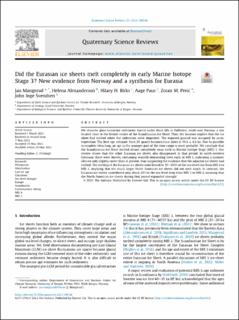Did the Eurasian ice sheets melt completely in early Marine Isotope Stage 3? New evidence from Norway and a synthesis for Eurasia
Mangerud, Jan; Alexanderson, Helena; Birks, Hilary H; Paus, Aage; Perić, Zoran M.; Svendsen, John Inge
Journal article, Peer reviewed
Published version

Åpne
Permanent lenke
https://hdl.handle.net/11250/3083823Utgivelsesdato
2023Metadata
Vis full innførselSamlinger
- Department of Earth Science [1034]
- Registrations from Cristin [9489]
Sammendrag
We describe glaci-lacustrine sediments buried under thick tills in Folldalen, south-east Norway, a site located close to the former centre of the Scandinavian Ice Sheet. Thus, the location implies that the ice sheet had melted when the sediments were deposited. The exposed ground was occupied by arctic vegetation. The best age estimate from 20 quartz luminescence dates is 55.6 ± 4.6 ka. Due to possible incomplete bleaching, an age in the younger part of the time range is most probable. We conclude that the Scandinavian Ice Sheet melted almost completely away early in Marine Isotope Stage (MIS) 3. Our review shows that the other Eurasian ice sheets also disappeared in that period. In north-western Germany, there were forests, containing warmth-demanding trees early in MIS 3, indicating a summer climate only slightly cooler than at present, thus supporting the evidence that the adjacent ice sheets had melted. The melting of the Eurasian ice sheets contributed to 50–100% of the sea-level rise from MIS 4 to MIS 3, implying that the much larger North American ice sheets did not melt much. In contrast, the Eurasian ice sheets contributed only about 30% to the sea-level drop from MIS 3 to MIS 2, meaning that the North American ice sheets during that period expanded strongly.
